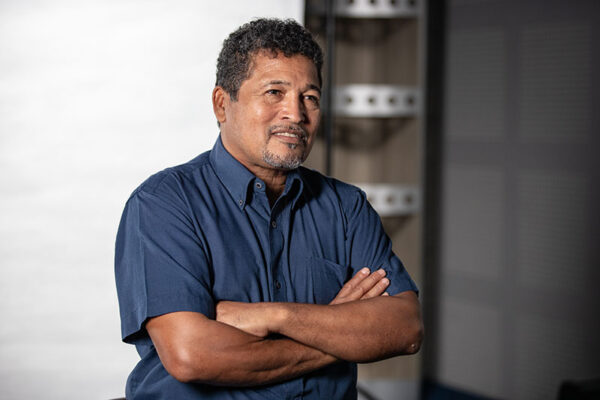A tragedy sublimated: Aristides Ureña Ramos and the invasion of Panama.
Set up on the playground at the Fatima Support Center in the heart of El Chorrillo, artist Aristides Ureña Ramos, […]
Set up on the playground at the Fatima Support Center in the heart of El Chorrillo, artist Aristides Ureña Ramos, brush in hand and shoes on his leather cutarras, toils away. Ureña captures on a large canvas, a moving tribute to the victims of the 1989 invasion of Panama. The documentary archives – the chronicles of the Mercedarian Brothers – together with photographs and oral testimonies of witnesses and survivors of the invasion, have been the source to feed, 32 years later, the mural entitled “El Chorrillo, December 20, 1989“.
This work is a series of three murals to be painted by the artist and commissioned by the Archbishopric of Panama. The first mural was unveiled in the Church of San Francisco de Asis in memory of those who died due to the Covid-19 and in the context of the Bicentennial of the Republic. The second was unveiled on December 20 in the Fatima Parish, remembering the invasion of Chorrillo, and the third will be dedicated to Santa Maria La Antigua. Death is the theme of two of these commissions, a central axis of great emotional weight, both for the community and for the artist.

War and art
Many societies and artists have sublimated the tragedy of war with art, in some cases motivated by great holocausts.
For example, the Spanish artist Pablo Picasso painted, commissioned by the government of the Second Spanish Republic, a large-format canvas commemorating the bombing of Guernica during the Spanish Civil War. On April 26, 1937, the German air force, with the support of the Italian government, bombed the Basque village of Guernica, leaving 127 people dead. The famous painting was exhibited that same year at the 1937 International Exposition in Paris (France).
In a closer context, the Ecuadorian Osvaldo Guayasamín, in his pictorial series called “The Age of Wrath” painted in 1976, “Napalm Head“, at the time of the revolutions in countries of the Latin American region. This painting represents the horrified face of a person with blank eyes, while burning with napalm, a gelatinous fuel that burns everything in contact with it and is used for war purposes.

The mural entitled “El Chorrillo, December 20, 1989” is probably the first large-format pictorial representation of the tragedy that occurred in the Chorrillo neighborhood.
The work There was no previous sketch for the work, Ureña Ramos points out, as he describes the details of the canvas before us.
“I thank the Archbishopric for not having conditioned the development of the work,” explains the artist. “The theme of the invasion is one of the events that, because of its violence and bloodshed, compromises a great intimacy of the inhabitants of El Chorrillo.”
The intimacy of which the artist speaks appears on the canvas with diverse elements of daily and personal materiality. In his creative process, the artist listens to simple and popular voices, such as that of a cook from the neighborhood who says that “all the dead went straight to heaven, they were not to blame for what happened to them”. The maelstrom he depicts recalls the ascension to heaven of the souls, which together with the Marian invocation of Fatima; they rise to heaven invoking divine mercy in a cloud of flowers and floats above the central scene.
“Who faces the mural of my work, will be able to identify the symbolic elements that gravitate on it; from the representation of the aggressor army with all the weight of violence it transmits, death, the physical-environmental context of a city that ceased to exist, to the Canal itself. I also understand that the Canal has only suspended the transit of ships because of the invasion and the storm La Purísima (2010); all those elements are there,” Ureña Ramos concludes.
Color
“Most of my works are in the turquoise palette; however, the one that evokes the tragedy of the invasion was done in a special red, one that evokes red beans.
The color of them on a white plate reminded me of the hunger and satiety that this humble food represents among the tables of Panamanians. On this intimate and personal level, that red gives color to my work and is the color of Panama,” the artist points out.
Art and the space of memory
The theme of the pictorial representation of a traumatic event for Panamanian society, such as the invasion, is part of the recognition and reconstruction of memory through art. The concept of memory space is a social construction that makes a reflection between urban spaces and the events that occurred in them.
This concept was detonated by the Holocaust of the Second World War, and in Latin America by the passage of military dictatorships in the 20th century. In Panama, we could refer it to the invasion of the American army in December 1989, and it could be extended to our transit history and the dead fallen during the construction and operation of the cobblestone roads, the dead from yellow fever and, finally, all those who died in the construction of the Canal by the United States.
“El Chorrillo, December 20, 1989”, a work by artist Aristides Ureña Ramos, merges in an interesting amalgam, art, memory and space, while offering an interpretation that will be subject to debate.
The pictorial work presented today by Ureña forces us to reflect on the conservation of the materiality left by the invasion and leaves a legacy that will assist the memory of the space, the events and the collective memory.